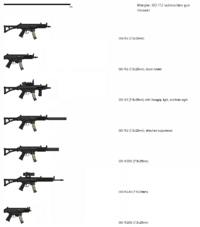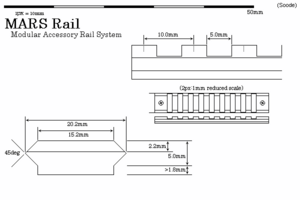Modular Accessory Rail System
The Modular Accessory Rail System, or MARS, is a rail integration system developed in Tír Glas to allow the mounting of scopes, iron sights, reflector sights, night vision devices, tactical lights, laser aiming modules, bipods, foregrips, and sling attachments on military firearms. It was later expanded to include the Modular Accessory Slot System, or MASS, which uses hollow slots in the handguard to achieve a similar purpose for a lighter weight, and MARS is sometimes used collectively to refer to both systems even though it technically only applies to the former.
MARS- and MASS-standard mounting systems have been adopted by the militaries of a number of other countries, including Dayashina and Menghe.
History
Interest in a single universal, standardized accessory mounting system for Glasic small arms began in the late 1980s. The MARS system was developed in response to the Army's requirements, and it was formally introduced in 1994.
Specifications
The Modular Accessory Rail System is based on the earlier Weaver rail mount, and consists of a flat-topped rail with an hourglass-like cross section and square grooves cut into it at regular intervals. Attachments are held into place by clamps that fit over the top and angled sides, as well as a screw or tooth running perpendicular through one of the cutouts to prevent forward or backward motion.
All measurements used in the MARS rail are based on the metric system. The teeth and gaps are 5mm wide and spaced 5mm apart, and the rails are 20.2mm across at their widest point and 15.2mm across at their narrowest point. There is no limit on the length of the rail, and optics and other accessories can be attached on whatever notch the user prefers.
MASS
Originally, MARS was intended to be used both on the upper receiver of a weapon and on all sides of the handguard, allowing the user to mount a wide variety of attachments as needed. While this allowed for high customizability, it also created other problems: the resulting receivers were heavy, uncomfortable to hold, and did not leave as much space for barrel ventilation.
The solution, designated the Modular Accessory Slot System, was officially unveiled in 2010. Rather than using protruding toothed rails, it attaches accessories to slots cut into the receiver itself, minimizing weight and providing ventilation for the barrel. The frame in which the slots are cut can be made of either metal or polymer, and torque specifications vary accordingly. As the resulting fit is not as secure as the fit from using a MARS rail, MARS is generally used on receivers to mount optics while MASS is generally used on handguards to mount other attachments.
Attachments are added using T-slot nuts that pass through the slot and tighten perpendicular on the other side, and the screws are typically treated with a thread-locking fluid that keeps them from shaking loose as the weapon is fired but also allows them to be unscrewed with a hex key as needed. Attaching and removing accessories can be done without accessing the far side of the handguard, i.e. while it is still mounted on the weapon.
Attachments can either be mounted directly to the handguard or mounted to a short MARS rail segment which is mounted on the frame as needed. In addition to preserving reverse compatibility, the latter option removes the need to redesign the accessory or mount to leave room for screws passing through it vertically.
Menghean service

For a long time, the Menghean Army was reluctant to embrace the widespread use of a rail-based modification system, though standard service rifles like the JS-67 and JS-103 were built with dovetail rails on the left side of the receiver to mount optics on extended arms. Some weapons, like early SS-110 marksman rifles, used dovetail rails on the upper receiver, but these were found to offer a less secure fit than a toothed rail system.
In 2011, the Menghean Army formally adopted both the MARS and MASS systems, and began producing them under license at a number of sites. Locally, MARS is designated the Type 111 weapon accessory mounting rail (111식 총기상 부대용품 표구 도궤 / 一一一式銃器上附帶用品表具導軌, il-il-il-sik chonggisang budaeyongpum pyogu dogwe) and MASS is designated the Type 111 weapon accessory mounting slot (111식 총기상 부대용품 표구 구멍 / 一一一式銃器上附帶用品表具--, il-il-il-sik chonggisang budaeyongpum pyogu gumŏn).


